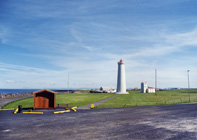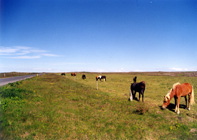Welcome to Vogar
First mentioned in Landnámabók, the medieval work which describes the settlement of Iceland in the 9th century, the village of Vogar lies on the north coast of the Reykjanes peninsula roughly midway between Reykjavik and Keflavik.
 As is the case with so many other settlements in Reykjanes, the story of Vogar and the fishing industry are one and the same. For hundreds of years, the harbour at Vogar was the key to rich fishing grounds off Vogastapi, so rich that they were known in Icelandic simply as Gullkistan, Chest of Gold.
As is the case with so many other settlements in Reykjanes, the story of Vogar and the fishing industry are one and the same. For hundreds of years, the harbour at Vogar was the key to rich fishing grounds off Vogastapi, so rich that they were known in Icelandic simply as Gullkistan, Chest of Gold.
At the turn of this century Vogar and the surrounding parish were home to some 750 peiple , at the time more than three times the population of Keflavik, but shortly afterwards this number dropped sharply as the harbour – and so the village went into decline, proving too small for the new motorized vessels then rapidly replacing the traditional six and eight-oared open boats which had served Icelanders for centuries.
Today however the population of Vogar is around 950, most who are engaged in fisheries or food processing.
Swimming pool
Vogar is home to a superb new swimming pool which comes equipped with a range of facilities including hot pots, saunas, solarium and gymnasium. The ideal place to soak up the rays on a sunny day, among the perks offered to guests are free coffee.
Out and about
With its lagoons, rocks and endless variety of birdlife, Vogar is a nature lover’s paradise, while the relatively flat access road to the region also make it highly popular amongst cyclists.
Vogastapi
 The old road around Reykjanes crossed Vogastapi, a promontory which today teams with colonies of seabirds. However, don’t be fooled by its innocent looking appearance. Vogastapi is also home to the dreaded Stapadraugurinn, a headless ghost said to prey on unwary travellers, sightings of whom have frequently been reported down through the years. So be warned!
The old road around Reykjanes crossed Vogastapi, a promontory which today teams with colonies of seabirds. However, don’t be fooled by its innocent looking appearance. Vogastapi is also home to the dreaded Stapadraugurinn, a headless ghost said to prey on unwary travellers, sightings of whom have frequently been reported down through the years. So be warned!
Vogatjörn
This tidal Lagoon serves as a breeding ground for ducks and waterfowl, including the world famous eider, whose rich soft down makes some of the warmest, most comfotable – and most expensive – guilts known to man.
Kálfatjarnarkirkja
A classic example of Icelandic rural church design, this picturesque building was built in 1893 and stands in the centre of the Vatnsleysuströnd region on the road to Reykjavik, and is one of Iceland’s largest country churches.
Staðarborg
On a clear day, the short climb from the chruch up to Staðarborg, a ring shaped ruin which once served as a sheep pen, is rewarded by some magnificent views of the moss-covered lava fields and jagged mountains of the Reykjanes region. Turn towards the sea, and the vista changes to the deep blue waters of Faxaflói bay, and the snow capped cone of Snæfellsjökull glacier, almost 100 km away to the west.
Vatnsleysustrandarvegur
Despite its nightmarish name, this peaceful country road appears on most maps simply as Route 421. Gravel surfaced and about 12 km long and is especially recommended for cyclists.








